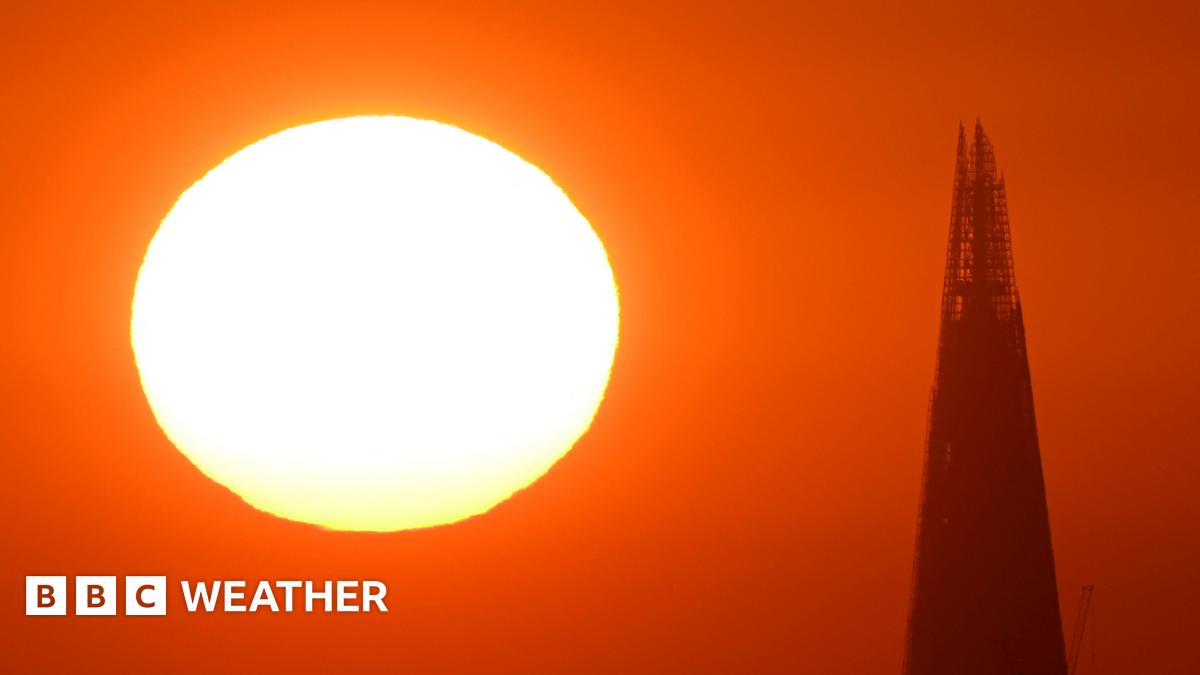The temperatures we are experiencing as part of the current heatwave are expected to peak on Monday in the cities of London and Cambridge. You may have noticed that temperatures are often much higher in urban areas than in the surrounding countryside. That is because of something called the urban heat island effect. It helps to explain why built-up areas can be several degrees warmer than nearby rural places, during the day and overnight. It leaves people living in cities more vulnerable to the impacts of climate change. During heatwaves, city centres are on average 4-6C (39-43F) warmer than surrounding areas according to theEuropean Commission Joint Research Centre,external. In extreme cases the difference can be as much as 10C (50F), especially in very calm weather with little wind to mix the air. A key reason for this contrast is the hard, dark-coloured surfaces, like buildings and roads, that dominate urban landscapes. They absorb the Sun's energy rather than reflecting it, meaning they store heat. This is then slowly released into the surrounding air leading to higher temperatures, especially at night. Waste heat generated by air conditioning units, vehicles - and humans - adds to this even further. The urban heat island effect is most pronounced in the largest cities, such as London In the countryside trees, rivers and lakes provide natural cooling and a source of moisture. Some of the Sun's energy is used in evaporating this moisture which leaves less to heat the land and the air, limiting the temperature rise. Cities tend to have less vegetation and fewer water sources meaning the ground and the air heat up more readily. This phenomenon also helps to explain why the very hottest days tend to be after a long spell of dry weather. The less moisture there is to evaporate, the more energy remains to lift temperatures. Extreme heat can be very uncomfortable and also dangerous. Dehydration andheat strokecan occur when temperatures rise, and urban heat island effects can also help to trap pollution leading to poor air quality. Climate change does not cause urban heat islands but because cities tend to be hotter, they are likely to be worst-affected by rising global temperatures. According to the UN, 55% of the world's population live in urban areas. This is projected to increase to 68% by 2050. As climate change makes heatwaves more frequent and more intense, it will be cities - and their growing populations - that bear the brunt of extreme heat and the significant impacts it can bring. Planners in some of the world's major cities are taking measures to mitigate and adapt to the building heat. InSingapore, authorities are incorporating open spaces,externalaround buildings and lighter colours on walls and roofs, as well as increasing the amount of greenery in the city. Nearly half of Singapore is now green space and more than half a million trees have been planted since 2020 - with an eventual target of one million trees by 2030. Singapore's meteorological service says the city is warming twice as quickly as the rest of the world In Spain, Barcelona has a growing network of more than 400 freeclimate shelters,externalwhere people can shelter from extreme summer heat as well as from winter cold. These offer a maximum temperature of 26C (79F) and must provide comfortable seating and free drinking water. Other cities including Paris, Buenos Aires and New York have introduced similar initiatives. Meanwhile in Phoenix, Arizona, researchers have been triallinglighter-coloured roadsand pavements in an attempt to reduce heat in the urban centre.
Why are UK cities often the hottest spots in the country?
TruthLens AI Suggested Headline:
"Urban Heat Island Effect: Why UK Cities Experience Higher Temperatures"
TruthLens AI Summary
The ongoing heatwave in the UK, particularly affecting cities like London and Cambridge, has highlighted the phenomenon known as the urban heat island effect. This effect results in urban areas experiencing significantly higher temperatures than their rural counterparts, with city centers averaging 4-6 degrees Celsius warmer during heatwaves. In extreme cases, this difference can reach up to 10 degrees Celsius, especially in calm weather conditions. The primary cause of this temperature disparity is the prevalence of hard, dark surfaces in cities, such as asphalt and concrete, which absorb and retain heat. Additionally, waste heat from air conditioning units, vehicles, and human activities further exacerbates the situation. In contrast, rural areas benefit from natural cooling mechanisms provided by vegetation, water bodies, and moisture, which help to mitigate temperature increases. This stark contrast in temperature dynamics leaves urban populations more vulnerable to the effects of climate change, particularly during heatwaves when dehydration and heat stroke become serious risks.
As the global population continues to shift towards urban living, with projections indicating that 68% will reside in cities by 2050, the implications of the urban heat island effect are becoming increasingly concerning. While climate change does not directly cause urban heat islands, cities, due to their inherent characteristics, are likely to experience the worst impacts of rising global temperatures. To address these challenges, urban planners in various cities worldwide are implementing strategies to combat the heat. Initiatives such as increasing green spaces, utilizing lighter building materials, and creating climate shelters are being adopted in cities like Singapore, Barcelona, and Phoenix. These measures not only aim to lower temperatures in urban environments but also enhance the quality of life for residents, making cities more resilient to the escalating risks associated with extreme heat and climate change. As heatwaves become more frequent and severe, the need for effective urban planning and adaptation strategies will be crucial in safeguarding the health and well-being of city dwellers.
TruthLens AI Analysis
You need to be a member to generate the AI analysis for this article.
Log In to Generate AnalysisNot a member yet? Register for free.
